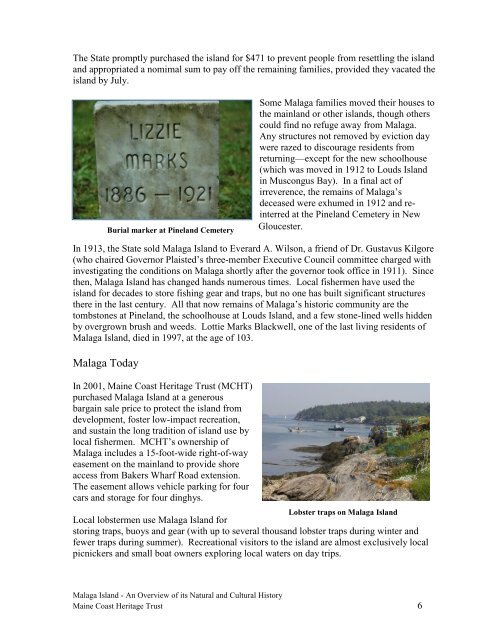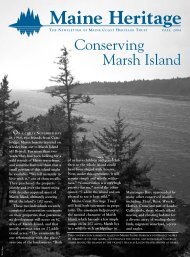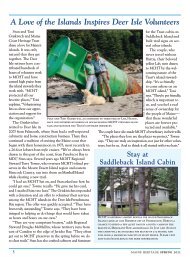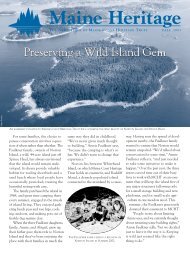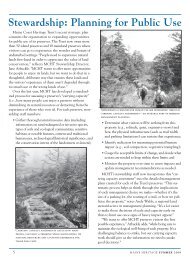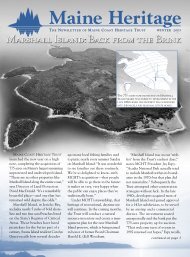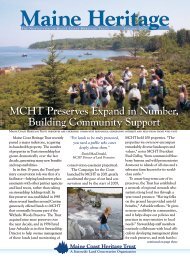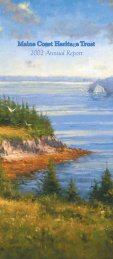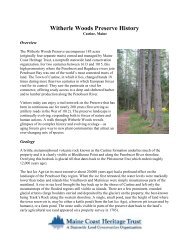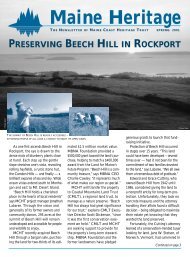Malaga Island - Maine Coast Heritage Trust
Malaga Island - Maine Coast Heritage Trust
Malaga Island - Maine Coast Heritage Trust
Create successful ePaper yourself
Turn your PDF publications into a flip-book with our unique Google optimized e-Paper software.
The State promptly purchased the island for $471 to prevent people from resettling the island<br />
and appropriated a nomimal sum to pay off the remaining families, provided they vacated the<br />
island by July.<br />
Burial marker at Pineland Cemetery<br />
Some <strong>Malaga</strong> families moved their houses to<br />
the mainland or other islands, though others<br />
could find no refuge away from <strong>Malaga</strong>.<br />
Any structures not removed by eviction day<br />
were razed to discourage residents from<br />
returning—except for the new schoolhouse<br />
(which was moved in 1912 to Louds <strong>Island</strong><br />
in Muscongus Bay). In a final act of<br />
irreverence, the remains of <strong>Malaga</strong>’s<br />
deceased were exhumed in 1912 and reinterred<br />
at the Pineland Cemetery in New<br />
Gloucester.<br />
In 1913, the State sold <strong>Malaga</strong> <strong>Island</strong> to Everard A. Wilson, a friend of Dr. Gustavus Kilgore<br />
(who chaired Governor Plaisted’s three-member Executive Council committee charged with<br />
investigating the conditions on <strong>Malaga</strong> shortly after the governor took office in 1911). Since<br />
then, <strong>Malaga</strong> <strong>Island</strong> has changed hands numerous times. Local fishermen have used the<br />
island for decades to store fishing gear and traps, but no one has built significant structures<br />
there in the last century. All that now remains of <strong>Malaga</strong>’s historic community are the<br />
tombstones at Pineland, the schoolhouse at Louds <strong>Island</strong>, and a few stone-lined wells hidden<br />
by overgrown brush and weeds. Lottie Marks Blackwell, one of the last living residents of<br />
<strong>Malaga</strong> <strong>Island</strong>, died in 1997, at the age of 103.<br />
<strong>Malaga</strong> Today<br />
In 2001, <strong>Maine</strong> <strong>Coast</strong> <strong>Heritage</strong> <strong>Trust</strong> (MCHT)<br />
purchased <strong>Malaga</strong> <strong>Island</strong> at a generous<br />
bargain sale price to protect the island from<br />
development, foster low-impact recreation,<br />
and sustain the long tradition of island use by<br />
local fishermen. MCHT’s ownership of<br />
<strong>Malaga</strong> includes a 15-foot-wide right-of-way<br />
easement on the mainland to provide shore<br />
access from Bakers Wharf Road extension.<br />
The easement allows vehicle parking for four<br />
cars and storage for four dinghys.<br />
Lobster traps on <strong>Malaga</strong> <strong>Island</strong><br />
Local lobstermen use <strong>Malaga</strong> <strong>Island</strong> for<br />
storing traps, buoys and gear (with up to several thousand lobster traps during winter and<br />
fewer traps during summer). Recreational visitors to the island are almost exclusively local<br />
picnickers and small boat owners exploring local waters on day trips.<br />
<strong>Malaga</strong> <strong>Island</strong> - An Overview of its Natural and Cultural History<br />
<strong>Maine</strong> <strong>Coast</strong> <strong>Heritage</strong> <strong>Trust</strong> 6


